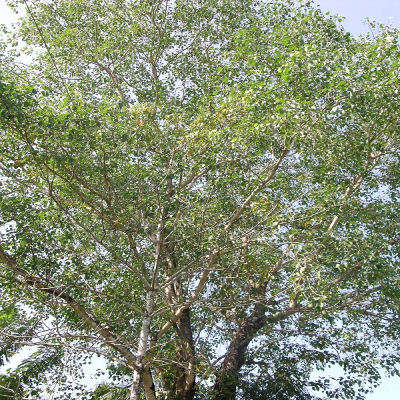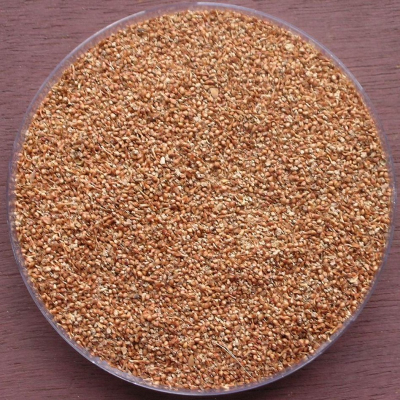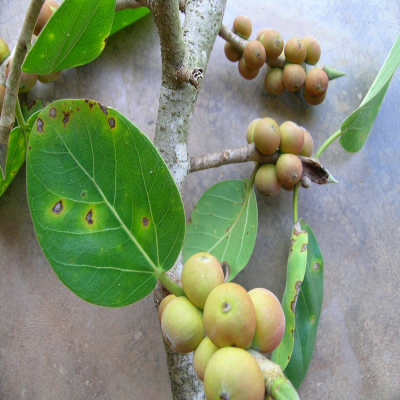Ficus benghalensis Linn.
Family : Moraceae
Group : 5. Nalpamaram, 6. Star trees, Antidiabetic
Parts Used : Fruit , Leaf , Bark , Bud , Latex , Aerial roots
Vernacular Names :-
| English | : | Banyan tree |
| Malayalam | : | Peral |
| Hindi | : | Bargad |
| Sanskrit | : | Nyagrodhah |
| Assamese | : | Bot |
| Bengali | : | Bot,Bargad |
| Kannada | : | Ala |
| Tamil | : | Alamaram |
| Telungu | : | Peddamari |
Distribution and Habitat: It is found in the Sub-Himalayan tract and Peninsular India. It is also grown throughout India.
Botany: Banyan tree is a laticiferous tree with reddish fruits, which is round .Aerial adventitious roots that look like many legs. It is very large up to 30 m in height with widely spreading branches bearing many aerial roots functioning as prop roots.
- Leaves: Simple, alternate, arranged often in clusters at the ends of branches. They are stipulate and 10-20 cm long.
- Fruit: Fruit is called syconium. It has small, crustaceous, achenes, enclosed in the common fleshy receptacles. Receptacles are axillary, sessile, seen in pair’s globose, brick red when ripe and enclosing male, female and gall flowers.
- Bark: is greenish white The young bark is somewhat smooth with longitudinal and transverse row of lenticels. In older bark, the lenticels are numerous and closely spaced; outer bark easily flakes off. The fresh cut surface is pink or flesh coloured and exudes plenty of latex. The inner most part of the bark adjoining the wood is nearly white and fibrous.
- Flowers : Flowers are unisexual. Male flowers dispersed with female, rather numerous near the mouth of the receptacles, pedicel 0.5-2.8 mm; female flowers sessile, glabrous, ovary superior, 1.5 mm x 1 mm; gall flowers similar to female but pedicellate. Flowering continuous throughout the year.
- Seeds : Tiny sandal coloured, 500-600nos. per fruit. Mature seeds are available from January to February.
Properties:
- Stem bark is an ingredient of Nalpamara’ and is widely used in treatment of skin diseases. Astringent bark is hypoglycemic, tonic, astringent, antidiarrhoeal and antidiabetic.
- Latex is anti- rheumatic.
- Seed is tonic.
- Leaf is diaphoretic.
- Root fibre is antigonorrhoeic
Chemical constituents:
- The bark yields flavanoid compounds leucoanthocyanidin and leucoanthocyanin. Both were effective as hypoglycemic agents.
- Leaves give friedelin, b-sitosterol, flavonoids- quercetin-3-galactoside and rutin.
- Heart wood gives tiglic acid ester of y- taraxasterol.
Uses: It is widely used in treatment of skin diseases with pitta and rakta predominance.
- Stem-bark, root -bark, aerial roots, leaves, vegetative buds and milky exudates are used in medicine. It improves complexion, cures erysipelas, burning sensation and vaginal disorders.
- An infusion of the bark cures dysentery, diarrhoea, leucorrhoea, menorrhagia, nervous disorders and reduces blood sugar in diabetes.
- The buds are useful in diarrhoea and dysentery. A decoction of the vegetative buds in milk is beneficial in hemorrhages.
- A paste of the leaves is applied externally to abscesses and wounds to promote suppuration, while that of young aerial roots cure pimples.
- Young twigs when used as a tooth brush strengthen gum and teeth.
- The aerial roots are useful in obstinate vomiting and leucorrhoea and are used in osteomalacia of the limbs.
- The latex is useful in neuralgia, rheumatism, lumbago, bruises, nasitis,ulitis, odontopathy, haemorrhoids, gonorrhoea, inflammations, and cracks of the sole and skin diseases.
Formulations: The drug forms an important constituent of formulations like Nalpamaradi Coconut oil, Saribadyasava, Kumkumadi taila, Khadira gulika, Valiyachandanadi taila, Candanasava, etc.
Agrotechnology
Soil and Climate: The tree requires a subtropical climate. In dry localities the trees become leafless for a short time in hot season. It requires rainfall of 500-4000 mm. It grows on a variety of soils including shallow and stony sites or even in rocky crevices. It also thrives on saline soil.
Propagation: By seeds, cuttings and air layering.
- Natural regeneration coming from seeds left over by birds, monkeys etc. Seeds germinate on buildings or on walls etc. Artificially seeds are collected from ripe fruits and washed well to remove fleshy aril. Seeds have viability up to 18 months. The dried seeds are sown on beds or polythene bags. The seeds germinate poorly, and hence should be sown thickly in seed beds and seedling pricked out into polybags after about one month. At 7-8 months age plant in prepared fields. Seed requirement per acre is 0.1 g.
- Cuttings having thickness of 15 - 25 mm are used. It takes 2-3 weeks to sprout. After 3 months plantout.
- Air layering is also practiced in the month of May to June; layering in branches of old trees registers 80 - 90% rooting.
Seed treatment : Soaking seeds in hot water at 65 degree Celsius for 10 minutes and sow in fine medium like leaf compost, composted coirpith etc.
Spacing : 6 m x 6 m
No. of plants per acre : 110 nos.



